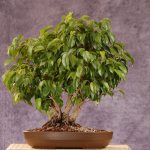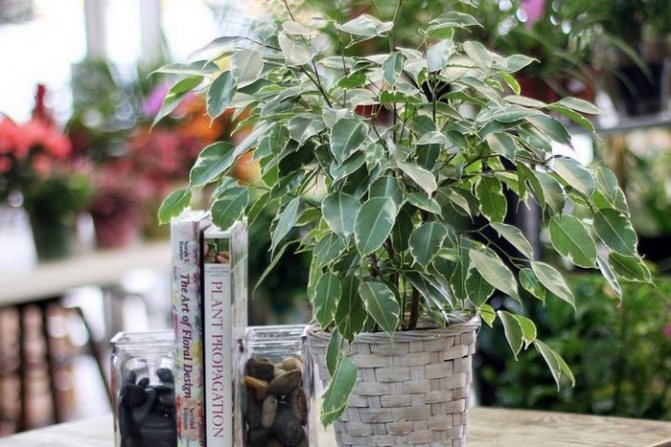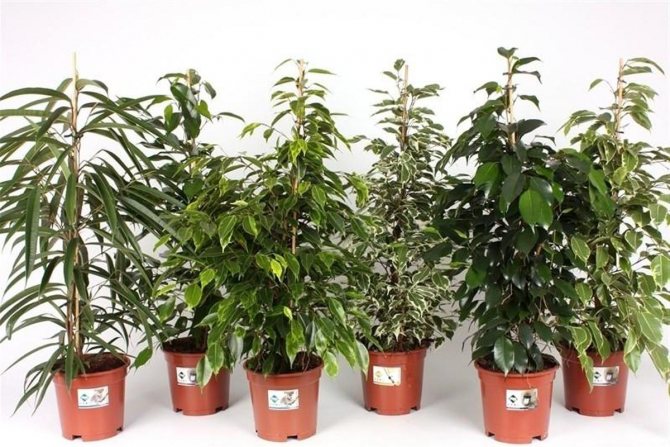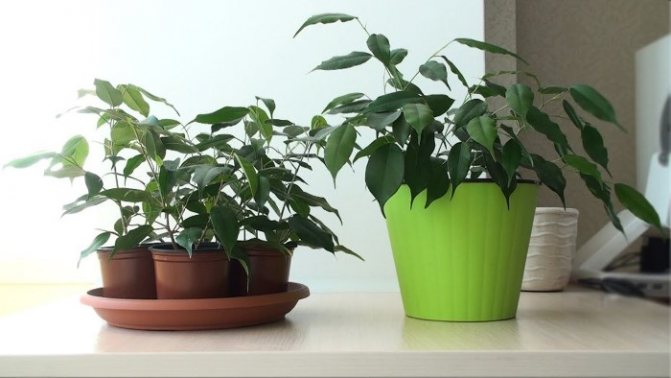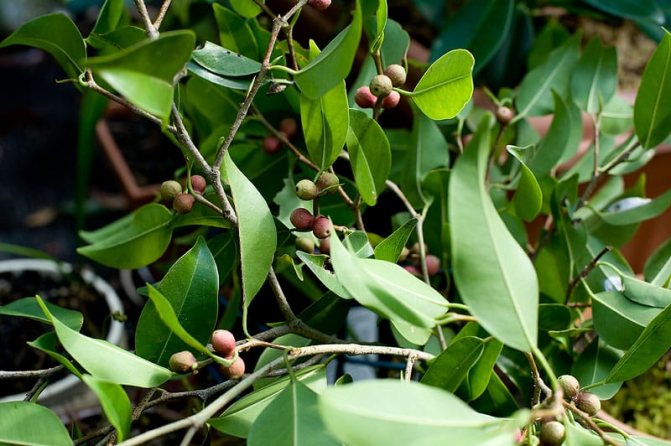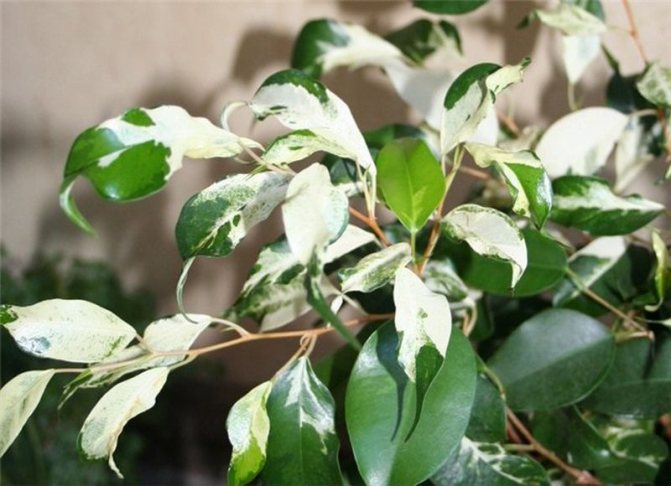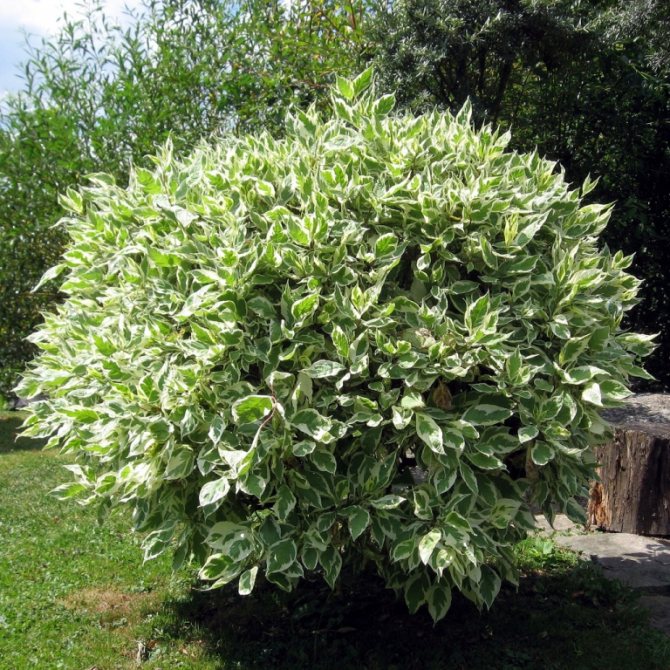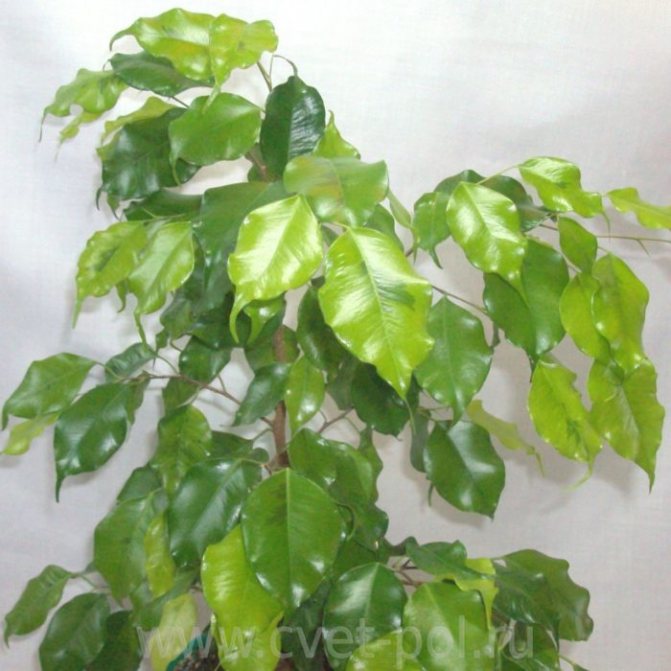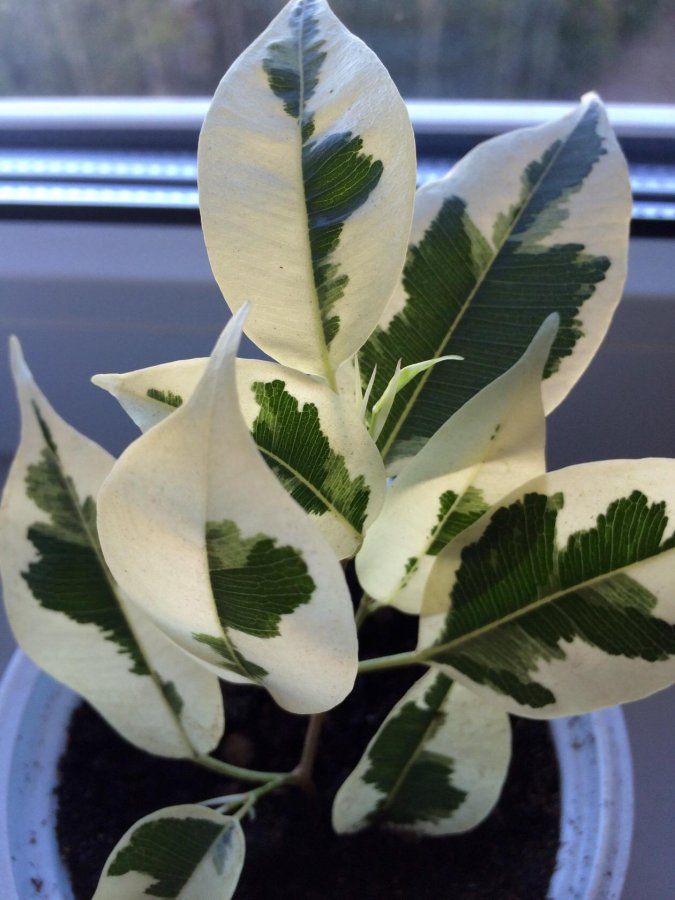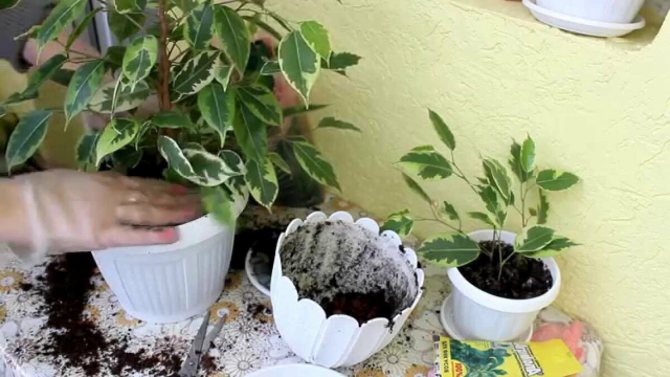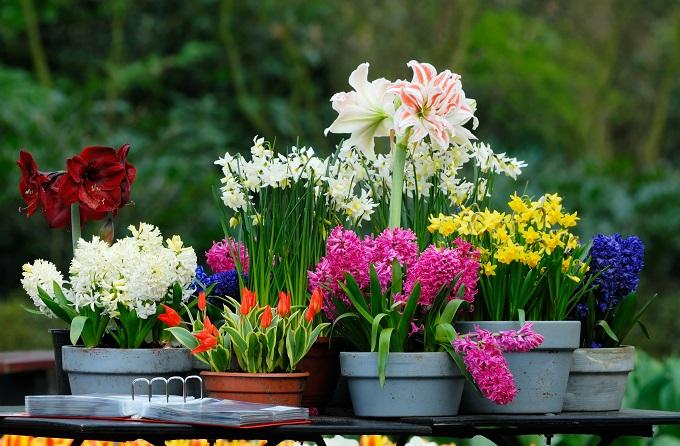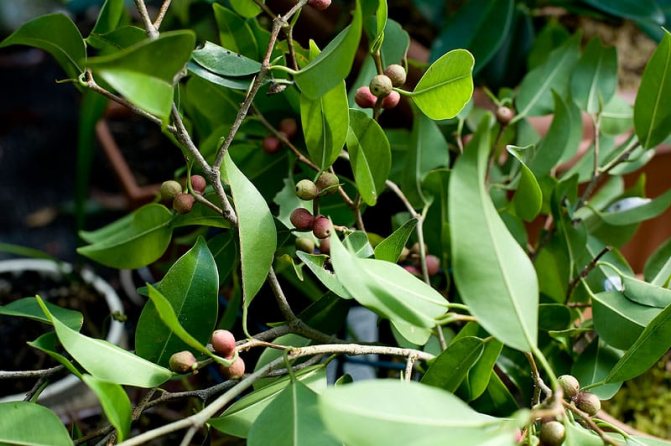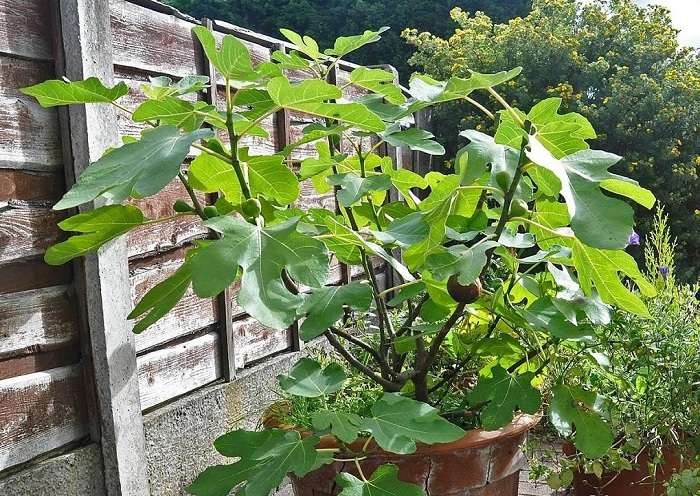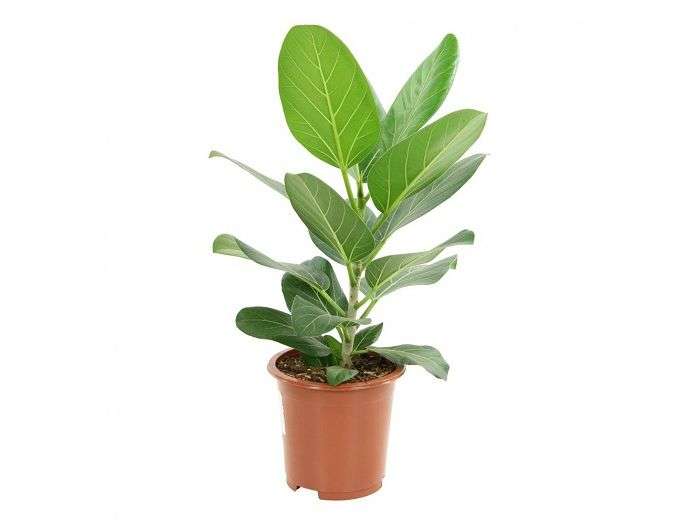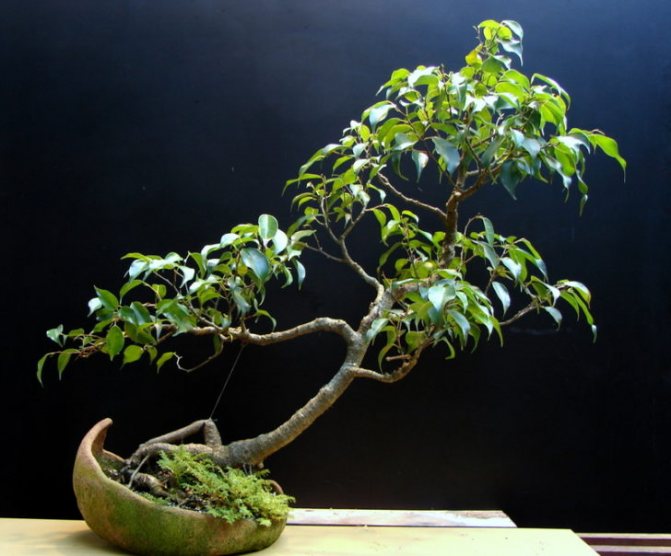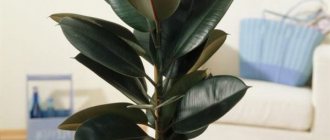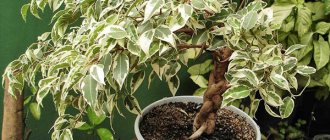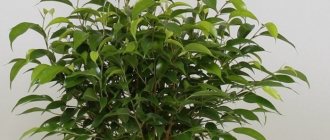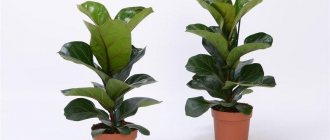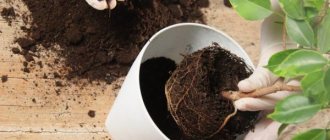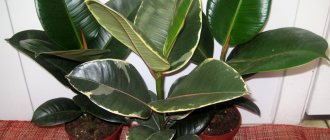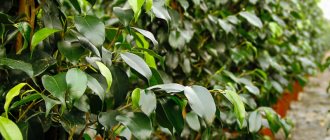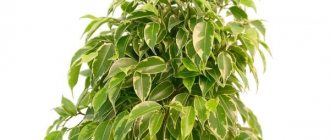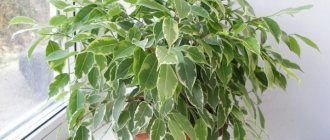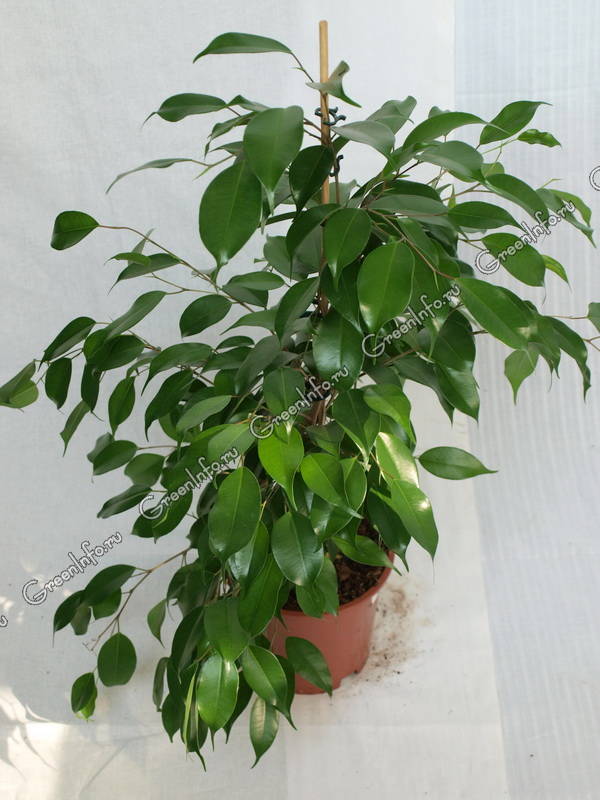
Ficus Benjamin
Ficus Benjamin, or brilliant (Ficus benjamina syn. Ficus nitida) - the most popular representative of the numerous genus of ficus, along with rubbery ficus. This is due to its high decorative qualities, simple and inexpensive growing process.
In its native conditions, in the tropics of South Asia and Northern Australia, where it is warm and rather humid all year round, Benjamin's ficus grows into a huge tree more than 30 meters high. Numerous aerial roots extend from its trunk and branches, which become additional support and often form a multi-stemmed banyan tree. Sometimes the trees grow so big that they form intricate sculptures. The roots penetrate into the ground to a depth almost equal to the height of the trunk, therefore, in countries of a tropical climate, it is necessary to protect sidewalks, communications and building foundations from their powerful destructive effect.
In drier countries, Benjamin's ficus is unable to form a banyan tree and grows as a single-stemmed tree. The branches droop beautifully, because of this feature it was also nicknamed "weeping ficus" or "weeping fig tree". The leaf blades are smooth, glossy, 3-10 cm (sizes vary greatly between varieties), elongated, with a sharp nose at the end, located in the same plane. Like all ficuses, Benjamin's ficus contains milky juice, sometimes it clearly appears on the leaves in the form of small white specks, often hardens in a droplet on the leaf petiole, (in contact with the skin, it can cause allergies). The flowers are inconspicuous, enclosed, like all ficuses, in a special capsule, and are pollinated only by a certain type of insect. The fruit in the form of syconium, in places of natural growth, serves as the main food for some species of birds. In areas with a tropical climate, Benjamin's ficus is actively used for landscaping, creating topiary forms and sheared hedges.
In the pot culture, Benjamin's ficus is widespread, but not always easy to maintain. It is necessary to take into account some of its features, and then the ficus in a pot will grow well and please the eye.
Popular types
There are several varieties of ficuses that have become especially popular due to their appearance, easy maintenance, and a fairly rapid growth rate. It is these types of crops that are most often found on sale in the form of grown plants and even seeds.
Ficus Benjamin
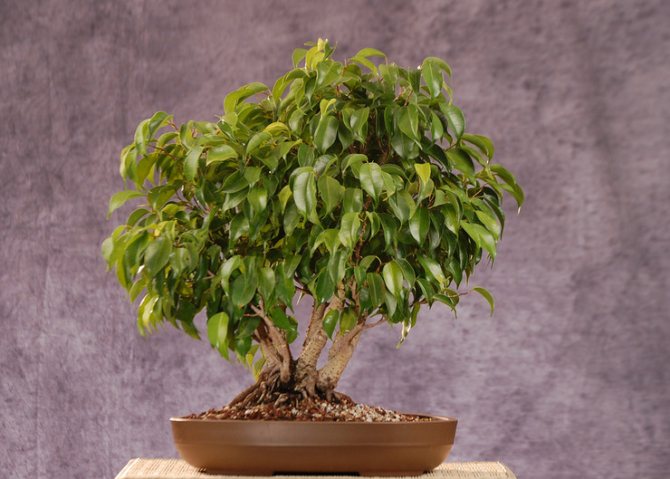

A tree-like variety of culture that is most common among florists. Outwardly it resembles a bonsai, but in comfortable conditions it can grow up to 2 m in height. Forms beautiful drooping branches with oval or ovoid leaves. Depending on the variety, they can have a different shade, texture. Ficus Benjamin with wavy leaf plates with a variegated color are especially appreciated.
Despite its great popularity, the plant needs special care. The tree does not like to change its location, and also likes constant moderate watering. Often, flower growers plant several plants next to each other in order to achieve an interlacing of aerial roots as they grow.
Rubbery (Elastic)
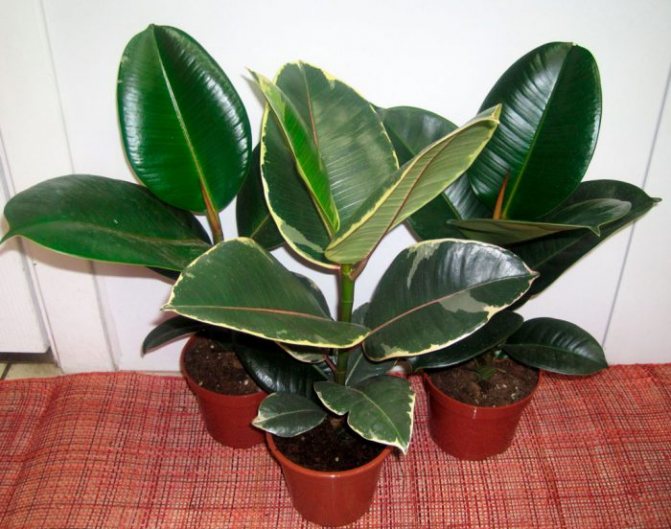

It was this type of ficus that until recently was the most popular for growing in an apartment.He is most often depicted in pictures and photos of this culture. The plant got its name due to the fact that the plant sap contains rubber, which is often used to make rubber.
It can grow to an impressive size. The powerful trunk reaches 2 meters in height, with proper pruning, the shoots branch out quite strongly. A distinctive feature is wide glossy leaves of a dark green hue, but variegated varieties have also been bred. Gradually, the lower parts of the plant fall off, which leads to the exposure of the trunk.
At high humidity, aerial roots form on the plant, which is used to create decorative compositions. If you create comfortable conditions, up to 1 new leaf is formed during the growing season. All parts of the plant are capable of purifying oxygen from harmful toxins.
Lyre-shaped
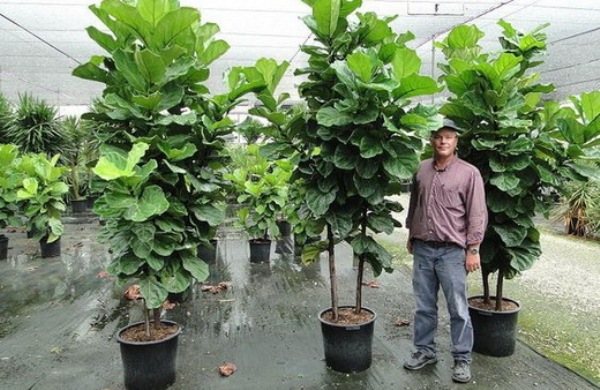

This type of ficus got its name because of its similarity to a musical instrument. Depending on the variety, it can be represented by a dwarf, medium-sized or rather tall tree up to 1.5 m high. The dark green foliage has a decorative wavy shape and can grow up to 50 cm in length, therefore, when growing a plant, it is advisable to choose the right place.
It does not form aerial roots at home, but is valued for its high growth rate. The plant is very light-requiring, with insufficient illumination, the attractiveness of leaves and shoots decreases. It has a pronounced dormant period, during which it is important to provide the plant with cool conditions in the range from 10 to 15 ° C.
Deltoid, or variegated
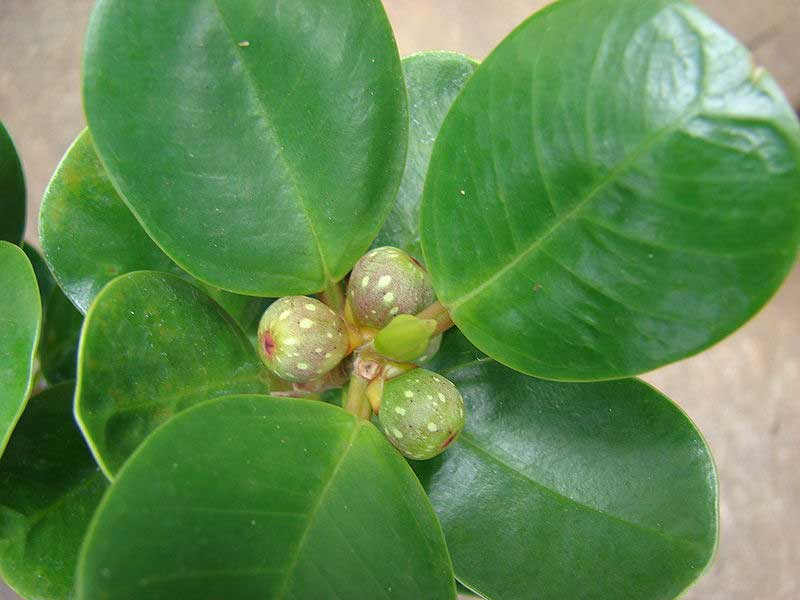

The homeland of this species is Southeast Asia. The species is named after the Greek letter delta, as the leaves are triangular in shape. In an adult state, it is represented by a voluminous bush with strong branching, many aerial roots.
Deltoid ficus is heterophilous - leaves of different shape and color can form on the same plant and even shoots. The bark of the trunk is colored in a beautiful gray-brown hue, and the leaf blades are usually glossy in color and a slight bulge. When grown, regular shaping is required to maintain the decorative effect of the plant.
Ficus Binnedika (Ali)
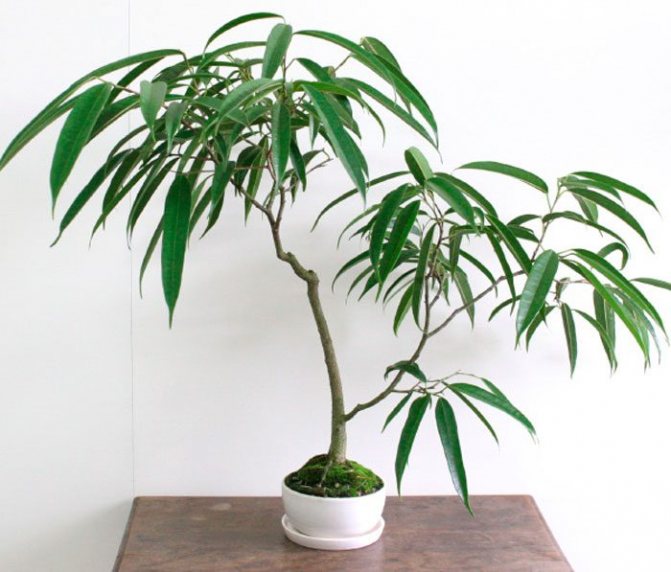

Evergreen ficus, found in the wild in South Asia. The plant is represented by a low tree with a decorative rough trunk. The leaves are drooping, have a traditional lanceolate shape. In adulthood, they grow up to 30 cm in length, while their width is only up to 2 cm. Depending on the variety, they can have a different color, leaf blades with a white border and a spotted light green pattern are especially popular.
Ficus Ali is a heat-loving plant that is sensitive to the effects of cold and drafts. There is no pronounced rest, therefore, it is recommended to make top dressing in winter. Suitable for the formation of a bonsai tree, but it is required to carry out competent shaping from the first year of growth.
Care rules
Caring for Benjamin's ficus is simple, it is enough to comply with several conditions for its content.
Watering and moisture
- The water should be boiled and at room temperature;
- In winter, watering is moderate;
- In the summer, water after the soil dries up to 3 cm in depth;
- Once a month arrange a warm shower in the bathroom;
- In summer, spray daily with water at room temperature;
- In winter, keep the plant away from batteries;
- Pour excess water from the pan;
- It is better to water in several passes, this will help the earth to be evenly saturated;
- In the room, you need to maintain a humidity of about 70% or put a jar of water next to the plant.
Lighting and temperature control
- Avoid direct sunlight;
- The place should be bright and well lit;
- If the variety has dark green leaves, then you can put it in partial shade;
- The plant does not tolerate drafts;
- Temperature must be above 16˚C;
- The room where the ficus is located must be regularly ventilated;
- So that the trunk is not crooked, the plant is periodically turned relative to the illuminated side.
Fertilizers
- Before fertilizing, the soil must be moist;
- You can add fertilizer to the water for irrigation;
- In the warm season, they are fed once every 2 weeks;
- Universal complex fertilizers containing microelements and NPK are best suited for the tree;
- After transplantation, you cannot feed for 45 days;
- Organic fertilizers are rarely used;
- In winter, no feeding is needed.
Priming
- The soil must be loosened regularly;
- It is better to use peat soil with the addition of sod land, sand and leaf humus;
- Leafy soil is enough for young ficuses;
- Plants over three years old need dense, nutritious soil.
Ampel ficuses
Despite the popular belief that ficus is a variety of domestic palms, ampelous varieties of culture are also known. They have a unique decorative effect, perfect for growing in hanging pots, decorating furniture and walls.
Rooting ficus
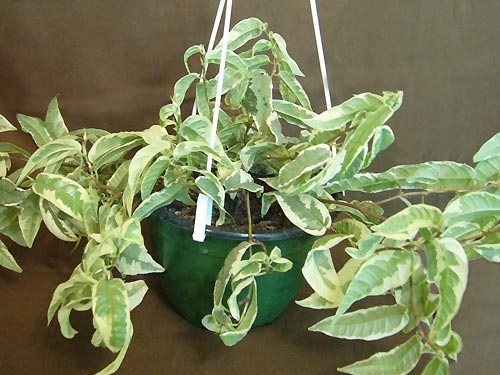

It is rare, usually this species can only be found in private collections. The native land of the plant is the tropical regions of India, it has been cultivated as a home plant since the middle of the last century. It has medium-sized drooping shoots, on which elongated leaves up to 5 cm long are alternately located.
Varieties with variegated color are especially appreciated. Suitable for growing in a hanging planter, but it feels best in a florarium, since high humidity of the air and soil is required for comfortable growth. It is also used to create decorative compositions in a large aquarium, it is able to stretch upwards if there is a strong support.
Dwarf (Pumila)
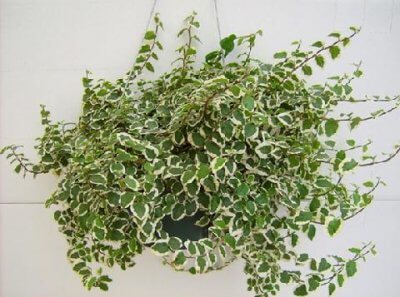

Another ampelous variety of ficus, the distribution area is Japan, China and some regions of Taiwan. In these countries, edible jelly is made from the fruits of dwarf ficus. One of the most unusual species of the Mulberry genus. The plant is represented by a creeping or ampelous plant with thin and delicate shoots up to 5 meters long.
Dark green or variegated leaves are heart-shaped, growing only up to 2.5 cm in diameter. Young leaf plates have an initially asymmetrical shape, which gradually changes. Varieties with small-leaved leaves up to 7 mm in length look especially decorative. High humidity should be maintained during cultivation, good lighting is required.
Mountain, or oak-leaved
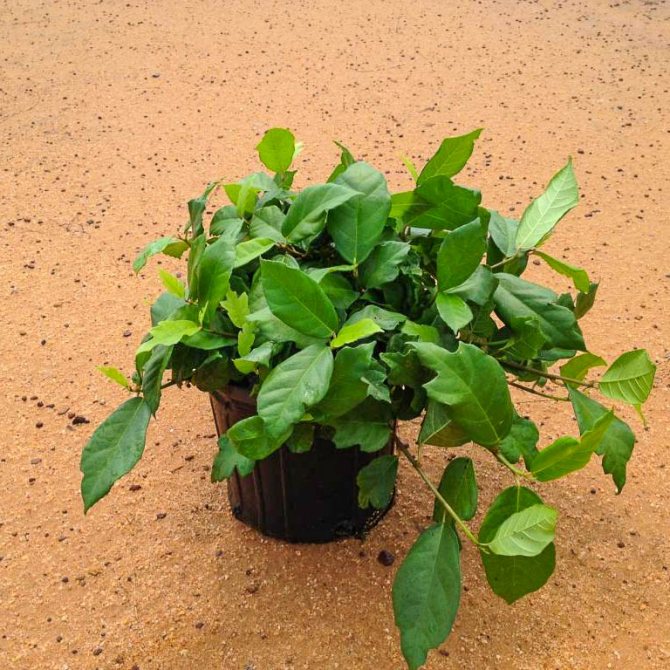

A low-growing ampelous species of ficus, the homeland of which is considered to be Indonesia and Malaysia. In Asian countries, this plant is considered a weed, as it often grows on tea plantations. As a home culture, it has become popular due to its high decorativeness and easy maintenance.
It has leaves that are unique in texture, the roughness of which is due to the presence of many small bristles on the surface. In adulthood, they grow up to 8 cm in length and up to 5 cm in width. In comfortable conditions, it can bear fruit, forms small pubescent berries up to 1.5 cm in diameter. Depending on the varietal series, they are colored red or yellow.
Trees
Among all the variety of ficuses, there are also tall trees. It is problematic to grow them at home, but such varieties are often represented by dwarf varieties that can be planted on the terrace or in the hallway.
Fig indoor (Karika)
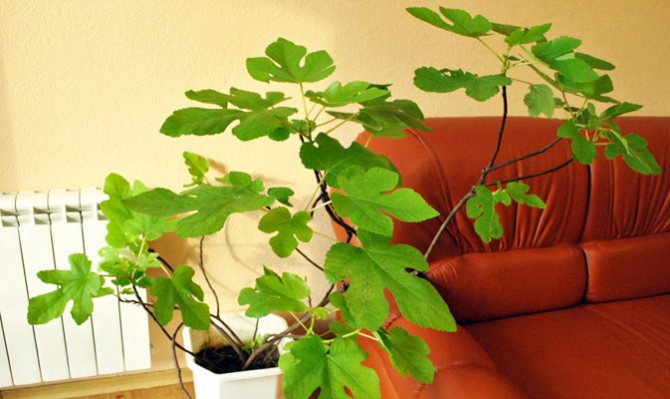

A dwarf fruit tree, widely used for growing in an apartment. Forms a thick lignified trunk of a gray-brown shade. In adulthood, the height of the plant does not exceed 1.5 meters.
Forms strong lignified shoots, on which serrated leaves with fine hairs are located.All parts of Karik ficus emit a specific odor, and also secrete a milky sap, which causes irritation upon contact with the skin. Small fruits are completely safe for health and are suitable for human consumption. Fruiting in an apartment is difficult to achieve.
Ficus sacred
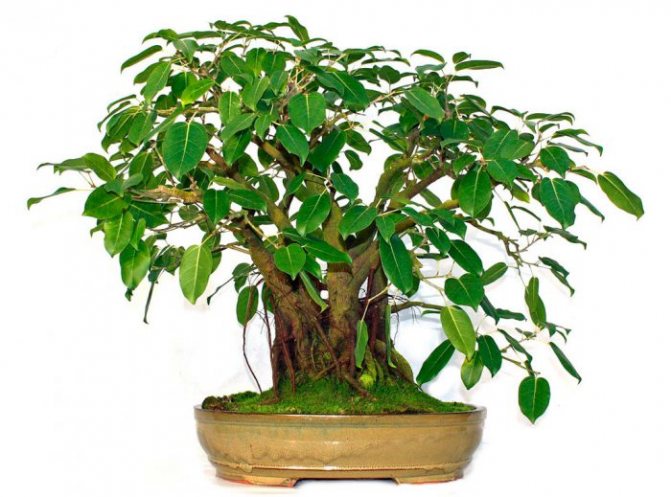

The homeland of this species is Southeast Asia. In India, the tree is revered - under the shadow of this ficus, Buddha attained enlightenment. On the territory of the country, you can find a tree that is more than 3 thousand years old.
In nature, the plant grows up to 30 m in height; in the conditions of an apartment, the ficus forms a medium-sized tree. It has a powerful stem with developed aerial roots that act as props. Poorly tolerates dry air and high temperatures. It is a deciduous culture, the leaves are extremely sensitive to external influences, they fall off even with minor changes. It is believed that this species of ficus can predict the weather - when the atmospheric pressure changes, droplets of juice appear on the leaves.
Bengali (Banyan)
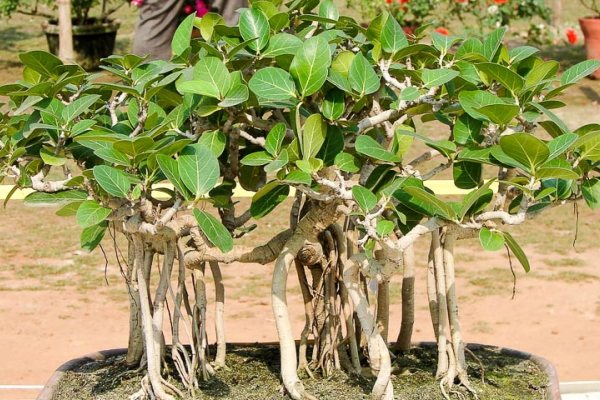

Another type of ficus, which is considered to be home to Southeast Asia. In ancient Indian manuscripts, the plant is a symbol of immortality. Outwardly, it is represented by a medium-sized tree with a fast growth rate. The plant is actively expanding in volume, a large number of new trunks are formed, which looks very decorative. In the wild, it begins its life as an epiphyte, is formed on a large tree, which the ficus gradually strangles with its aerial roots, due to which it strengthens and grows.
When grown at home, the growth rate should be inhibited by regular and high-quality pruning, especially when planting ficus in a limited container. With proper care, syconia appear on the plant - a kind of spherical inflorescences, colored orange.
Transfer
Ficus Benjamin is transplanted in the spring. A young plant - once a year, and ficuses over 4 years old - once every 3 years. The acquired trees are transplanted into a permanent pot after a month.
There are several factors that indicate that it is time to replant the plant:
- The pot is small and the roots are visible in the drainage hole;
- The need to change the ground;
- Plant propagation;
- Rapid drying out of the earth;
- The leaves began to turn yellow;
Sometimes it is enough to simply renew the topsoil, but it is better to carry out a complete transplant of the plant. To do this, choose a pot 3 cm larger than the previous one. Drainage is laid out on the bottom of the bowl.
A small tree easily tolerates transplanting using the transshipment method. Before the process, the soil must be well moistened, because it is especially important to preserve the root ball. After transplanting, it will be possible to water the tree after 2 days. But you need to spray the handsome man regularly.
Bottle ficuses
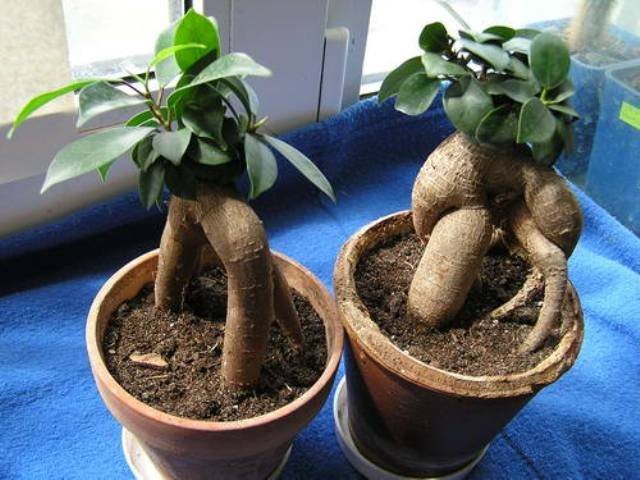

This group includes several species with similar botanical features. The most common of them are ficus petiolate and Palmera. In the wild, they are found in Mexico, the oldest specimens are truly gigantic in size.
Bottle ficuses form a caudex - a trunk with a thickening in the lower part, in which excess water accumulates. The plant is often used to form bonsai. For cultivation, it is recommended to use low and wide pots, the plant has a shallow root system. Both types of ficuses of this group have a dormant period when it is necessary to lower the air temperature. They are unpretentious in care, do not require frequent watering.
Ficuses are a multi-species group of plants widely used for growing in an apartment and office. The features of care and maintenance requirements are very different for different species. When choosing a variety for an apartment, one should take into account the peculiarities of development, the volume of vegetative parts and requirements for external conditions.
Diseases and pests, control methods
Diseases are more often associated with improper care. Root rot can develop due to over-watering.In case of damage, it is necessary to remove all damaged areas, reduce the number of irrigations. Treat the ficus with products containing copper (copper sulfate). If the culture has undergone bacterial infections, then, unfortunately, it will have to be destroyed completely.
Ficus Benjamin pests:
- spider mite;
- mealybug;
- aphid.
To kill parasites, it is recommended to treat the plant with soapy water. Wash it off under a warm shower.
If the lesions are serious, you will need to resort to the help of insecticides:
- Aktara;
- Fitoverm;
- Karbofos.
For greater efficiency, it is better to process it 2-3 times.

